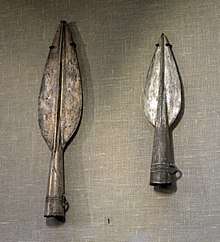Seima-Turbino phenomenon

Seima-Turbino phenomenon refers to a pattern of burial sites with similar bronze artifacts dated from 2100 BCE to 1900 BCE found across northern Eurasia, from Finland to Mongolia, which has suggested a common point of cultural origin, advanced metal working technology, and unexplained rapid migration. The buried were nomadic warriors and metal-workers, travelling on horseback or two-wheeled chariots. The name derives from the Seima (Sejma) cemetery at the confluence of the Oka River and Volga River, first excavated around 1914, and the Turbino cemetery in Perm, first excavated in 1924.
Description
The Seima-Turbino phenomenon refers to a pattern of burial sites dating from 2100 BCE to 1900 BCE.[1] (Originally dated to 1650 BCD onwards.[2]) found across northern Eurasia, from Finland to Mongolia, which has suggested a common point of cultural origin, advanced metal working technology, and unexplained rapid migration. The buried were nomadic warriors and metal-workers, travelling on horseback or two-wheeled chariots. The name derives from the Seima (Sejma) cemetery at the confluence of the Oka River and Volga River, first excavated around 1914, and the Turbino cemetery in Perm, first excavated in 1924.[3]
The bronze in Seima-Turbino weapons is identified as containing tin based bronze originating from ore from the Altai Mountains region. Seima-Turbino type bronzes have been discovered as far west as at the Borodino treasure in Moldavia.[4][5] The bronzes found were technologically advanced for the time, including lost wax casting, and showed high degree of artist input in their design.[6]
These cultures are noted for being nomadic forest and steppe societies with metal working, sometimes without having first developed agricultural methods.[7] The development of this metalworking ability appears to have taken place quite quickly.[8]
The Altai Mountains in what is now southern Russia and central Mongolia have been identified as the point of origin of the cultural enigma of Seima-Turbino Phenomenon.[7] The culture spread from these mountains to the west.[8] Artefact types such as spearheads with hooks, single-bladed knives and socketed axes with geometric designs traveled west.[9]
Although they were the precursor to the much later Mongol invasions, these groups were not yet strong enough to attack the important social sites of the Bronze Age.[10]
Theory of introduction of bronze into S.E. Asia
It has been conjectured that changes in climate in this region around 2000 BC and the ensuing ecological, economic and political changes triggered a rapid and massive migration westward into northeast Europe, eastward into China and southward into Vietnam and Thailand across a frontier of some 4,000 miles - supposedly this migration took place in just five to six generations and led to peoples from Finland in the west to Thailand in the east employing the same metal working technology and, in some areas, horse breeding and riding.[11] However, further excavations and research in Ban Chiang and Ban Non Wat, Thailand argue the idea that Seima-Turbino brought metal workings into southeast Asia is based on inaccurate and unreliable radiocarbon dating at the site of Ban Chiang. It is now agreed by virtually every specialist in Southeast Asian prehistory, that the Bronze Age of Southeast Asia is too late to relate to Seima-Turbino, and the cast bronzes are quite different. .[12]
The same authors conjectured that the same migrations spread the Uralic languages across Europe and Asia.[11] However, recent genetic testings of sites in south Siberia and Kazakhstan (Andronovo horizon) would rather support a spreading of the bronze technology together with Indo-European language migrations eastwards, as this technology was well known for quite a while in western regions.[13][14]
References
- ↑ Marchenko et al. 2017.
- ↑ Anthony 2007, pp. 447.
- ↑ A Dictionary of Archaeology, edited by Ian Shaw, Robert Jameson, page 517
- ↑ Frachetti, Michael David, Pastoralist Landscapes and Social Interaction in Bronze Age Eurasia, pp. 52–3
- ↑ Anthony 2007, pp. 444-7.
- ↑ Anthony 2007, pp. 443-4.
- 1 2 Anthony 2007.
- 1 2 Chernykh, E.N. (2008). "Formation of the Eurasian "Steppe Belt" of Stockbreeding cultures". Archaeology, Ethnology and Anthropology of Eurasia. 35 (3): 36–53. doi:10.1016/j.aeae.2008.11.003.
- ↑ Chernykh 1992, p.220-21, figs. 74, 75.
- ↑ Christian 1998.
- 1 2 Keys, David (January 2009). "Scholars crack the code of an ancient enigma". BBC History Magazine. 10 (1): 9.
- ↑ Higham, C.; Higham, T.; Kijngam, A. (2011), "Cutting a Gordian Knot: the Bronze Age of Southeast Asia: origins, timing and impact", Antiquity, 85 (328): 583–598, doi:10.1017/S0003598X00067971
- ↑ Lalueza-Fox, C.; Sampietro, M. L.; Gilbert, M. T. P.; Castri, L.; Facchini, F.; Pettener, D.; Bertranpetit, J. (2004), "Unravelling migrations in the steppe: mitochondrial DNA sequences from ancient central Asians", Proceedings of the Royal Society B: Biological Sciences, 271 (1542): 941–947, doi:10.1098/rspb.2004.2698, PMC 1691686, PMID 15255049
- ↑ Keyser, Christine; Bouakaze, Caroline; Crubézy, Eric; Nikolaev, Valery G.; Montagnon, Daniel; Reis, Tatiana; Ludes, Bertrand (2009), "Ancient DNA provides new insights into the history of south Siberian Kurgan people", Human Genetics, 126 (3): 395–410, doi:10.1007/s00439-009-0683-0, PMID 19449030
Sources
- Christian, David (1998), A history of Russia, Central Asia, and Mongolia, ISBN 978-0-631-20814-3
- Anthony, David W. (2007), The Horse, the Wheel, and Language: How Bronze-Age Riders from the Eurasian Steppes Shaped the Modern World
- Marchenko, Z. V.; Svyatko, S. V.; Molodin, V. I.; Grishin, A. E.; Rykun, M. P. (Oct 2017), "Radiocarbon Chronology of Complexes With Seima-Turbino Type Objects (Bronze Age) in Southwestern Siberia", Radiocarbon, 59 (5): 1381–1397, doi:10.1017/RDC.2017.24
- Chernykh, E. N. (1992), Wright, Sarah, ed., Ancient Metallurgy in the USSR, The Early Metal Age, Cambridge University Press
External links
| Wikimedia Commons has media related to Seima-Turbino phenomenon. |